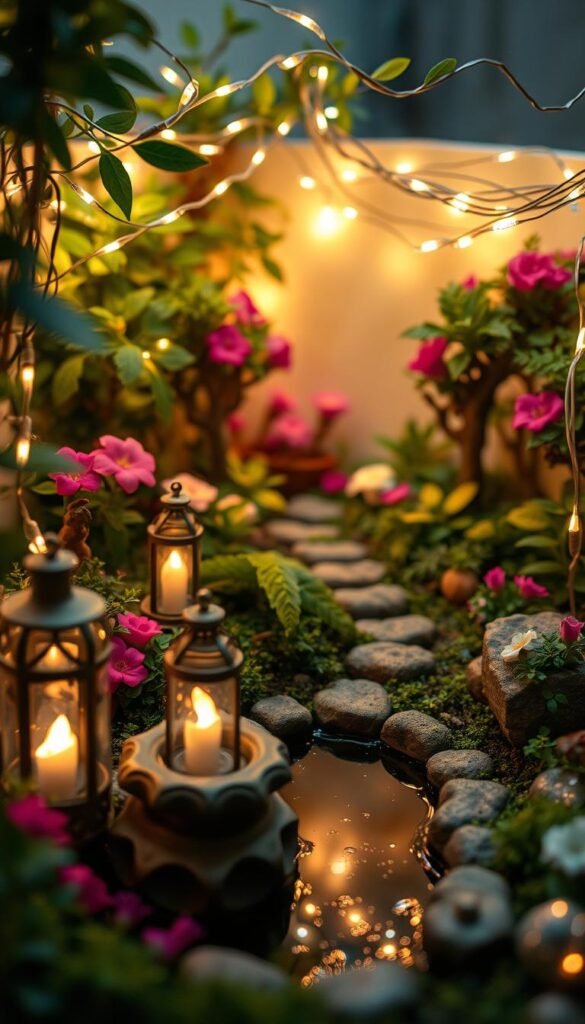Imagine turning your outdoor space into a magical retreat that shines day and night. Twinkling accents aren’t just for holidays—they can elevate your landscape year-round. Whether draped over shrubs or tucked into pathways, these delicate elements bring warmth and character to even the coziest corners.
The right illumination does more than highlight your favorite plants. It creates inviting spots for relaxation and socializing, extending your enjoyment of the outdoors. Studies show soft lighting can boost mood, making your sanctuary feel like a true escape.
You’ll learn how to use string lights, solar-powered options, and waterproof designs to craft scenes that captivate. For example, pairing subtle glow with water features and fairy lights adds motion and reflection, doubling the enchantment.
Safety matters too. We’ll guide you through choosing weather-resistant fixtures and strategic placement to keep your display sparkling safely. Ready to transform your space? Let’s begin.
Setting the Stage for a Magical Miniature Garden
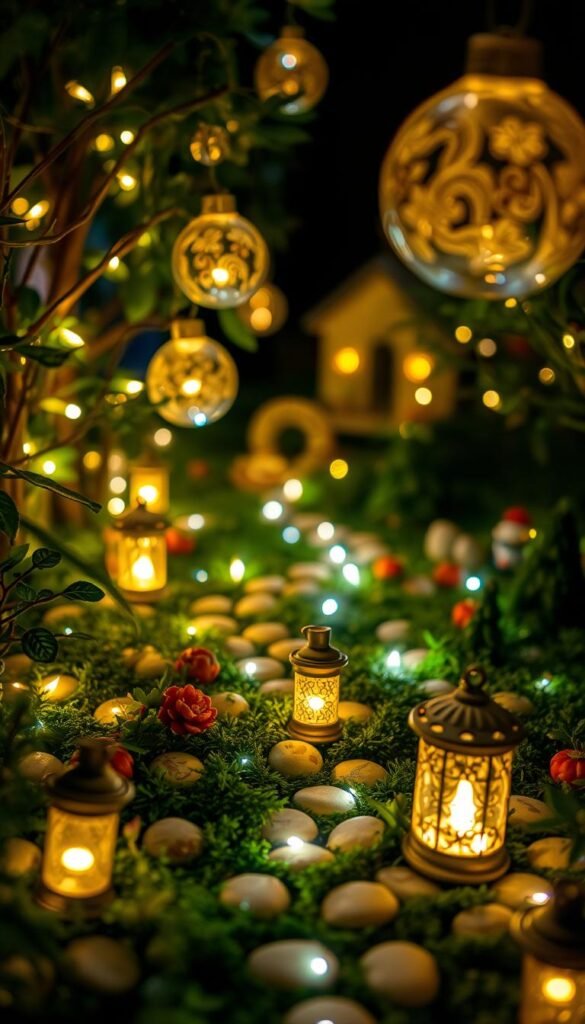
Transform your outdoor nook into a glowing sanctuary that shines after sunset. Thoughtful illumination serves as the backbone of miniature design, blending practicality with visual charm. It turns cramped areas into welcoming retreats while emphasizing your favorite decor pieces.
Why Soft Glow Makes All the Difference
Gentle lighting does more than brighten paths—it shapes moods. Research shows warm tones lower stress levels by 23% compared to harsh bulbs. This approach encourages lingering conversations and transforms your space into a social hub after dark.
Essential Components for Maximum Impact
Pair illumination with low-growing plants and textured stones to create depth. For patio container gardening, use upward-facing lights to showcase planters. Neutral-colored accessories reflect light best, making arrangements appear larger.
Consider color temperatures carefully. Amber tones (2700K-3000K) foster relaxation, while cooler whites (4000K+) energize. Layer different heights and intensities to guide the eye through your layout. Dimmable options let you adjust atmospheres for dinners or solo relaxation.
Understanding Garden Fairy Lights and Lanterns
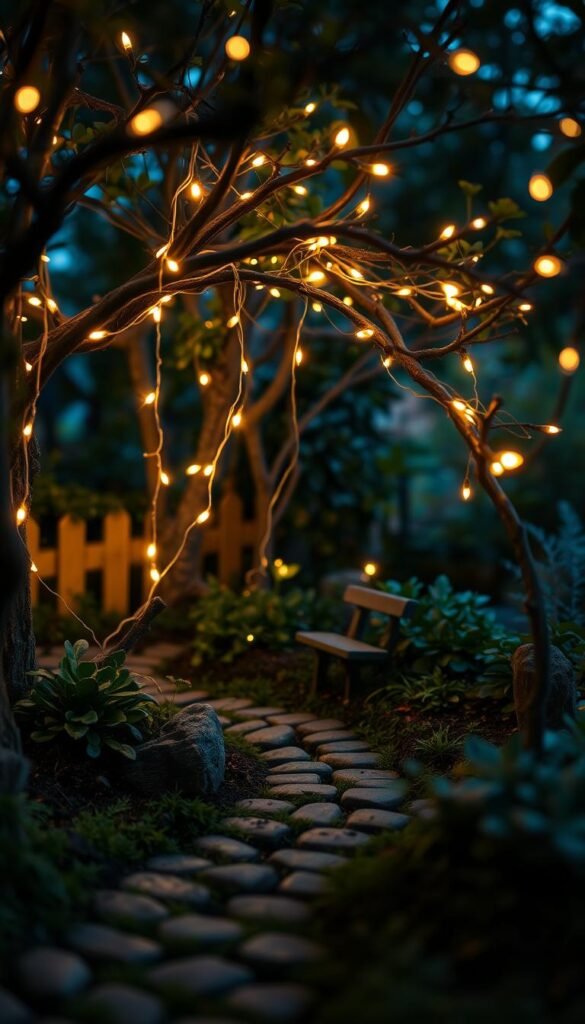
Creating an inviting glow starts with choosing the right tools. From delicate strands to cascading patterns, each style serves distinct purposes in landscape design. Let’s explore popular choices and smart setup strategies.
Different Types: String Lights, Curtain Lights, and More
String lights remain a classic pick for outlining structures or wrapping tree trunks. Their flexibility works well in tight spaces. Curtain varieties create vertical drama when hung from pergolas, while net styles evenly cover bushes like sparkling blankets.
LED options run cooler than traditional bulbs, making them safer near plants. Incandescent types offer nostalgic warmth but require more energy. Solar-powered units eliminate outlet dependence, perfect for remote corners.
Tips for Safe and Effective Installation
Always check for weather-resistant ratings (look for IP65+ codes). Use outdoor-rated extension cords and secure connections with waterproof tape. “Layered lighting creates depth without overwhelming the space,” notes a landscape designer from Texas.
Calculate total wattage before connecting multiple strands. Leave slack in wires for seasonal temperature changes. For elevated displays, fasten clips every 12 inches to prevent sagging.
Choosing the Right Lights for Your Outdoor Space
Selecting the perfect illumination for your yard or patio starts with understanding your options. String lights and fairy lights each bring unique strengths to outdoor lighting, but their best uses depend on your vision and practical needs.
String Lights vs. Fairy Lights: Which is Best?
String lights feature larger bulbs spaced farther apart, ideal for illuminating wide areas like pergolas or fences. Their bold glow creates a festive atmosphere perfect for gathering spots. Fairy lights, with tiny LEDs clustered closely, excel at highlighting intricate details—think winding through flower beds or framing a birdbath.
Durability matters. Look for IP65-rated options if your area gets heavy rain or snow. “Layered designs using both types can balance coverage and delicacy,” suggests a Colorado-based landscape architect. Solar-powered fairy lights work well in shaded corners, while plug-in string lights handle longer runs.
Assess your space’s power access and support structures. Do you have outlets nearby, or will solar panels suffice? Measure vertical surfaces for hanging and ground areas for stake lights. Warmer tones (2700K–3000K) soften modern layouts, while cooler whites sharpen rustic themes.
Budget-friendly tip: Prioritize weather-resistant materials over decorative extras. A 50-foot copper-wire fairy light strand often costs less than classic Edison bulbs but delivers equal charm. Mix high-impact focal points with subtle accents to stretch your budget further.
Garden Fairy Lights and Lanterns: Adding Ambience to Your Miniature Scene
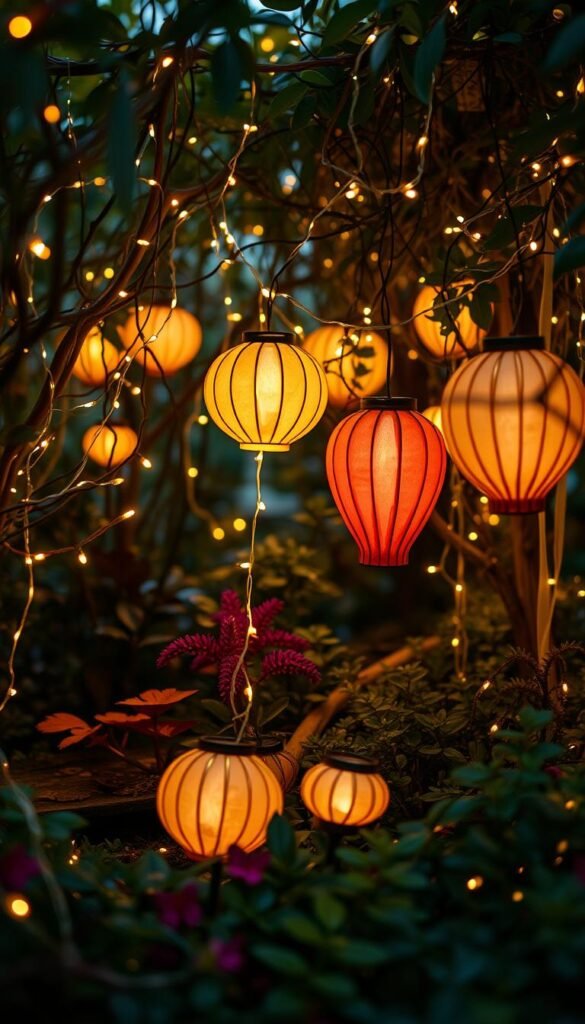
Elevate your outdoor charm with layered light sources that work in harmony. While fairy lights provide delicate sparkle, lanterns add structure and directionality to your design. Together, they create depth that makes small spaces feel thoughtfully curated.
Incorporating Lanterns for Versatile Lighting
Mix materials and heights for dynamic effects. Hang metal lanterns above seating areas to cast patterned shadows on tabletops. Cluster glass jars wrapped with copper wire along pathways for ground-level guidance. “Layered lighting creates focal points that draw people deeper into the space,” notes a New England landscape designer.
Solar-powered options shine in hard-to-reach corners, while vintage styles complement fairy garden arrangements. Try nesting battery-operated fairy lights inside weathered tin containers. The perforations create star-like effects without overpowering nearby plants.
Enhancing Visual Appeal with a Soft Glow
Aim for warmth that flatters foliage without blinding guests. Dimmable LED candles in lanterns let you adjust brightness for dinners versus quiet evenings. Place smaller units near reflective surfaces like water bowls to amplify their reach.
Vary lantern sizes to guide the eye naturally through your layout. Tall pole-mounted designs work behind ferns, while tea light holders perched on stones highlight ground covers. For DIY charm, line mason jars with moss and nestle fairy lights inside—perfect budget-friendly accents.
Remember: spacing prevents visual clutter. Leave breathing room between light sources to let each glow stand out. This balance turns functional lighting into an artful display that evolves with the dusk.
Creative Ideas for Hanging and Displaying Your Lights
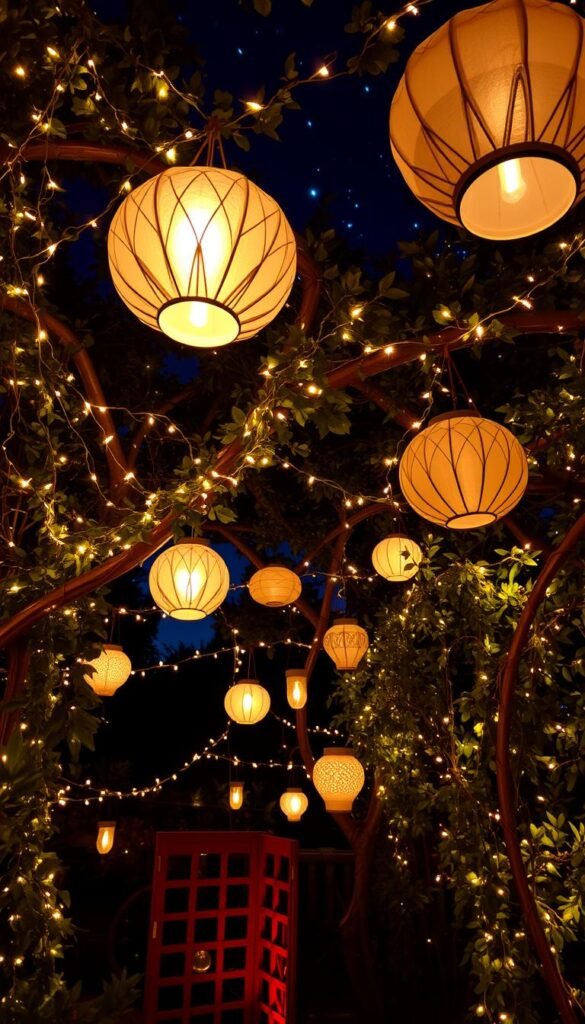
Bring new life to your outdoor spaces by reimagining how you hang and position illumination. Clever arrangements blend function with creativity, turning simple string lights into showstopping features. Let’s explore methods that elevate ordinary setups into cohesive designs.
Draping Techniques for a Cohesive Look
Drape strands from tree branches to rooflines using adjustable hooks. This creates flowing arcs that highlight architectural details. For uniform spacing, measure 12-18 inches between connection points—this prevents sagging while maintaining rhythm.
Wooden pallets make excellent backdrops when wrapped horizontally. “Natural elements like fence posts or trellises offer built-in anchor points,” says a California lighting designer. Create tent effects over seating areas by crisscrossing lights between poles or tall planters.
Repurposing Everyday Items for Unique Displays
Turn an old ladder into a vertical showcase by weaving string lights through its rungs. Vintage bicycles propped against walls become whimsical fixtures when adorned with tiny bulbs. Even watering cans gain charm when filled with solar-powered strands peeking through their spouts.
Mason jars wrapped in chicken wire hold tea lights securely while casting intricate shadows. For stability, use outdoor-safe adhesives and check waterproof ratings. These ways use common objects prove imagination trumps expensive gear.
Transforming Your Patio and Garden Area
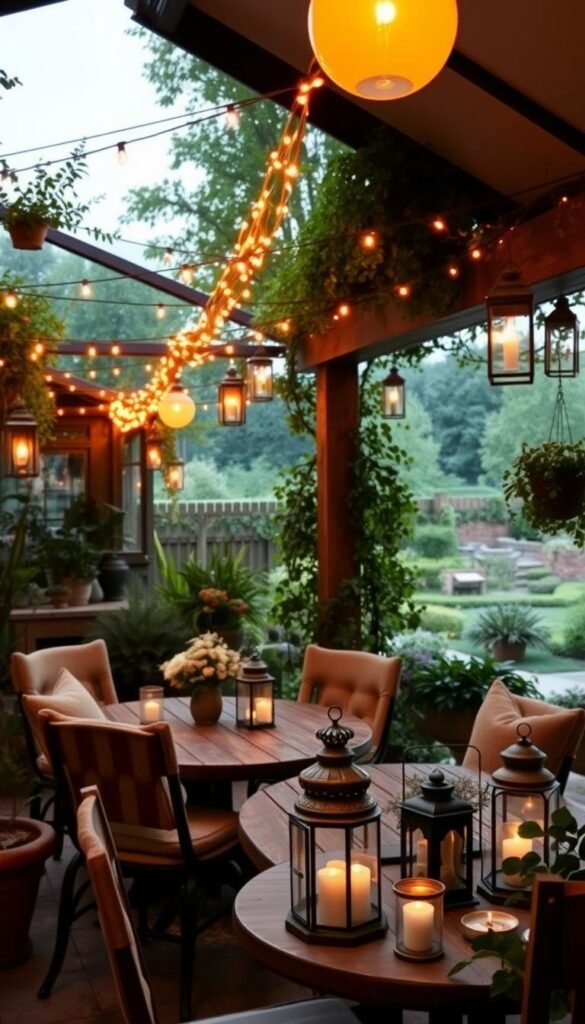
Turn your backyard into a welcoming oasis where meals and memories blend seamlessly under the stars. Strategic outdoor lighting elevates dining experiences while making your patio feel like an extension of your home. Focus on balancing aesthetics with practicality to create spaces that shine day and night.
Lighting Up Dining Areas and Outdoor Entertaining Spots
Start by framing your dining table with warm overhead illumination. Hang outdoor string lights in crisscross patterns above seating zones to mimic cozy café atmospheres. Lavin Label recommends spacing bulbs 12-18 inches apart for even coverage that’s bright enough for meals yet soft for conversation.
Incorporate these elements for maximum impact:
- Use weather-resistant lanterns as centerpieces to cast flickering shadows across tabletops
- Wrap patio pillars with waterproof LED strips for subtle accent lighting
- Install dimmer switches to transition from lively gatherings to intimate dinners
For larger areas, layer different heights. Mount wall sconces at eye level and place ground lights near pathways. “Always test your lighting at night,” advises a Texas-based designer. “What looks subtle at dusk might vanish after dark.”
Choose materials that withstand local weather patterns. Powder-coated metal fixtures resist rust, while solar-powered options reduce maintenance. Keep cords hidden using planters or decorative rocks for a polished finish that prioritizes both safety and style.
DIY Projects: Crafting Your Own Fairy Light Decor
Personalize your outdoor space with handmade lighting creations that reflect your style. These budget-friendly ideas let you craft unique pieces while avoiding generic store-bought options. Whether you’re sprucing up a patio or enhancing DIY garden art, these projects blend functionality with creative flair.
Creating a DIY Fairy Light Chandelier
Transform a hula hoop into a glowing centerpiece. Wrap white fairy lights around the frame, securing them with cable ties every 6 inches. Attach ribbons to three equidistant points for hanging, then suspend from a sturdy ceiling hook.
| Material | Cost | Difficulty |
|---|---|---|
| Hula hoop (24″) | $8 | Beginner |
| LED string lights | $12 | Beginner |
| Outdoor ribbon | $5 | Beginner |
Building a Rustic Lantern Display
Upcycle mason jars and reclaimed wood for charming pathway markers. Nestle battery-operated fairy lights inside jars, then mount them on wooden posts using weatherproof adhesive. Space them 3 feet apart along walkways for consistent illumination.
For added texture, wrap twine around the jars before inserting lights. This technique creates diffused glow perfect for country-style spaces. Always use silicone sealant around jar openings to protect against rain.
Safety first: Choose low-voltage options (12V or less) for all outdoor projects. Check connections monthly for corrosion, and avoid overloading circuits. With these ideas, you’ll create eye-catching decor that lasts through seasons.
Insights from Top Home and Garden Inspirations
Professional designers reveal clever strategies to blend illumination with nature seamlessly. Discover how leading experts transform ordinary spaces into enchanting areas that balance style and practicality.
Design Tips from Lavin Label and Sugar Maple Notes
Lavin Label’s signature approach pairs string lights with tabletop lanterns for intimate dining setups. “The key lies in creating pockets of warm light,” their team notes. Position lanterns at varying heights around your patio table to mimic professional candlelit ambiance without fire hazards.
Meanwhile, Sugar Maple Notes champions dual-purpose solutions. Wrap wooden support poles with climbing plants like ivy or clematis. This hides structural elements while adding vertical greenery. Pair with solar-powered uplights at the base for evening drama.
Three principles unite these ideas:
- Use living elements to soften technical components
- Prioritize adjustable brightness for different occasions
- Let existing landscape features guide placement
For photography-ready results, designers suggest clustering lights near reflective surfaces. A water feature or glossy plant leaves can double your glow. These techniques work in compact urban patios or sprawling backyard spaces.
Remember: Great lighting feels discovered, not installed. Tuck strands behind trellises and let lanterns peek through foliage. This creates the illusion your home’s magic grew naturally from the ground up.
Multi-Season Ambience: Beyond the Holiday Glow
Your outdoor space deserves charm beyond December nights. Those twinkling strands often packed away post-holidays can elevate your evenings year-round when chosen thoughtfully. Warm white or clear options blend seamlessly with seasonal decor, from spring blooms to autumn leaves.
Using Outdoor Lights All Year Long
Wrap christmas lights around tree trunks for summer gatherings or line pathways during crisp fall evenings. Solar-powered varieties automatically adjust to daylight changes, saving you time while maintaining evening allure.
Mix them with lanterns or woven through pergolas to create depth. Durable, weather-resistant designs withstand rain and snow, ensuring your display lasts through seasons. Rotate placements every few months to keep the look fresh without overwhelming the space.
For outdoor lighting ideas that adapt, choose neutral tones that complement both holiday wreaths and summer potted plants. This approach lets you enjoy cozy nights under the stars—no matter the time of year.

